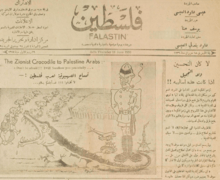Mandatory Palestine
Mandatory Palestine[lower-alpha 1][1] (Arabic: فلسطين Filasṭīn; Hebrew: פָּלֶשְׂתִּינָה (א"י) Pālēśtīnā (EY), where "EY" indicates Eretz Yisrael Land of Israel) was a geopolitical entity established between 1920 and 1948 in the region of Palestine under the terms of the Mandate for Palestine.
Mandatory Palestine | |||||||||||||
|---|---|---|---|---|---|---|---|---|---|---|---|---|---|
| 1920–1948 | |||||||||||||
.svg.png) Mandatory Palestine in 1946 | |||||||||||||
| Status | Mandate of the United Kingdom | ||||||||||||
| Capital | Jerusalem | ||||||||||||
| Common languages | English, Arabic, Hebrew | ||||||||||||
| Religion | Islam, Judaism, Christianity, Baha'i Faith, Druze faith | ||||||||||||
| High Commissioner | |||||||||||||
• 1920–1925 (first) | Sir Herbert L. Samuel | ||||||||||||
• 1945–1948 (last) | Sir Alan G. Cunningham | ||||||||||||
| Historical era | Interwar period, World War II | ||||||||||||
• Mandate assigned | 25 April 1920 | ||||||||||||
• Britain officially assumes control | 29 September 1923 | ||||||||||||
| 14 May 1948 | |||||||||||||
| Currency | Egyptian pound (until 1927) Palestine pound (from 1927) | ||||||||||||
| |||||||||||||
| Today part of | |||||||||||||
Part of a series on the |
|---|
| History of Israel |
 |
| Ancient Israel and Judah |
| Second Temple period (530 BCE–70 CE) |
| Late Classic (70-636) |
| Middle Ages (636–1517) |
| Modern history (1517–1948) |
| State of Israel (1948–present) |
| History of the Land of Israel by topic |
| Related |
|
|
Part of a series on the |
|---|
| History of Palestine |
-Temple_Mount-Dome_of_the_Rock_(SE_exposure).jpg) |
| Prehistory |
| Ancient history |
| Classical period |
|
| Islamic rule |
| Modern era |
|
|
During the First World War (1914–18), an Arab uprising and the British Empire's Egyptian Expeditionary Force under General Edmund Allenby drove the Turks out of the Levant during the Sinai and Palestine Campaign.[2] The United Kingdom had agreed in the McMahon–Hussein Correspondence that it would honour Arab independence if they revolted against the Ottomans, but the two sides had different interpretations of this agreement, and in the end, the UK and France divided up the area under the Sykes–Picot Agreement—an act of betrayal in the eyes of the Arabs. Further complicating the issue was the Balfour Declaration of 1917, promising British support for a Jewish "national home" in Palestine. At the war's end the British and French set up a joint "Occupied Enemy Territory Administration" in what had been Ottoman Syria. The British achieved legitimacy for their continued control by obtaining a mandate from the League of Nations in June 1922. The formal objective of the League of Nations mandate system was to administer parts of the defunct Ottoman Empire, which had been in control of the Middle East since the 16th century, "until such time as they are able to stand alone."[3]
During the British Mandate period the area experienced the ascent of two major nationalist movements, one among the Jews and the other among the Palestinian Arabs. The competing national interests of the two populations against each other and against the governing British authorities matured into the Arab Revolt of 1936–1939 and the Jewish insurgency in Mandatory Palestine, before culminating in the 1947–1949 Palestine war. This led to the establishment of the 1949 cease-fire agreement, with partition of the former Mandatory Palestine between the newborn state of Israel with a Jewish majority, the Arab West Bank annexed by the Jordanian Kingdom and the Arab All-Palestine Protectorate in the Gaza Strip under Egypt.
Name
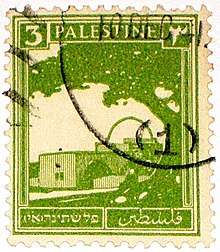
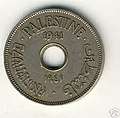

.jpg)
The name given to the Mandate's territory was "Palestine," in accordance with local Palestinian Arab and Ottoman usage[4][5][6][7] as well as European traditions.[lower-alpha 2] The Mandate charter stipulated that Mandatory Palestine would have three official languages, namely English, Arabic and Hebrew.
In 1926, the British authorities formally decided to use the traditional Arabic and Hebrew equivalents to the English name, i.e. filasţīn (فلسطين) and pālēśtīnā (פּלשׂתינה) respectively. The Jewish leadership proposed that the proper Hebrew name should be ʾĒrēts Yiśrāʾel (ארץ ישׂראל=Land of Israel). The final compromise was to add the initials of the Hebrew proposed name, Alef-Yud, within parenthesis (א״י), whenever the Mandate's name was mentioned in Hebrew in official documents. The Arab leadership saw this compromise as a violation of the mandate terms. Some Arab politicians suggested that there should be a similar Arabic concession, such as "Southern Syria" (سوريا الجنوبية). The British authorities rejected this proposal; according to the Minutes of the Ninth Session of the League of Nations' Permanent Mandates Commission:
Colonel Symes explained that the country was described as "Palestine" by Europeans and as "Falestin" by the Arabs. The Hebrew name for the country was the designation "Land of Israel," and the Government, to meet Jewish wishes, had agreed that the word "Palestine" in Hebrew characters should be followed in all official documents by the initials which stood for that designation. As a set-off to this, certain of the Arab politicians suggested that the country should be called "Southern Syria" in order to emphasise its close relation with another Arab State.[9]
History
1920s
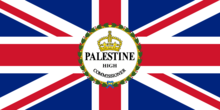
Following the arrival of the British, the inhabitants established Muslim-Christian Associations in all the major towns.[10] In 1919 they joined to hold the first Palestine Arab Congress in Jerusalem.[11] It was aimed primarily at representative government and opposition to the Balfour Declaration.[12]
The Zionist Commission formed in March 1918 and became active in promoting Zionist objectives in Palestine. On 19 April 1920, elections took place for the Assembly of Representatives of the Palestinian Jewish community.[13]
In July 1920 a civilian administration headed by a High Commissioner replaced the military administration.[14] The first High Commissioner, Herbert Samuel, a Zionist and a recent British cabinet minister, arrived in Palestine on 20 June 1920 to take up his appointment from 1 July.
_(14780310121).jpg)
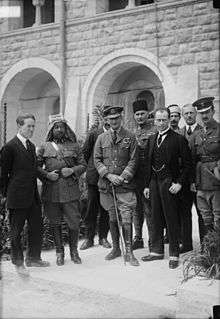

One of the first actions of the newly installed civil administration was to begin granting concessions from the Mandatory government over key economic assets. In 1921 the government granted Pinhas Rutenberg — a Jewish entrepreneur — concessions for the production and distribution of electrical power. Rutenberg soon established an electric company whose shareholders were Zionist organisations, investors, and philanthropists. Palestinian-Arabs saw it as proof that the British intended to favour Zionism. The British administration claimed that electrification would enhance the economic development of the country as a whole, while at the same time securing their commitment to facilitate a Jewish National Home through economic—rather than political—means.[15]
In March 1920, there was an attack by Arabs on the Jewish village of Tel Hai. In April, there was another attack on Jews, this time in Jerusalem. In May 1921, almost 100 died in rioting in Jaffa after a disturbance between rival Jewish left wing protestors was followed by murderous attacks by Arabs on Jews.
Samuel tried to establish self-governing institutions in Palestine, as required by the mandate, but the Arab leadership refused to co-operate with any institution which included Jewish participation.[16] When Grand Mufti of Jerusalem Kamil al-Husayni died in March 1921, High Commissioner Samuel appointed his half-brother Mohammad Amin al-Husseini to the position. Amin al-Husseini, a member of the al-Husayni clan of Jerusalem, was an Arab nationalist and Muslim leader. As Grand Mufti, as well as in the other influential positions that he held during this period, al-Husseini played a key role in violent opposition to Zionism. In 1922, al-Husseini was elected President of the Supreme Muslim Council which had been established by Samuel in December 1921.[17][18] The Council controlled the Waqf funds, worth annually tens of thousands of pounds[19] and the orphan funds, worth annually about £50,000, as compared to the £600,000 in the Jewish Agency's annual budget.[20] In addition, he controlled the Islamic courts in Palestine. Among other functions, these courts had the power to appoint teachers and preachers.
The 1922 Palestine Order in Council[21] established a Legislative Council, which was to consist of 23 members: 12 elected, 10 appointed, and the High Commissioner.[22] Of the 12 elected members, eight were to be Muslim Arabs, two Christian Arabs, and two Jews.[23] Arabs protested against the distribution of the seats, arguing that as they constituted 88% of the population, having only 43% of the seats was unfair.[23] Elections took place in February and March 1923, but due to an Arab boycott, the results were annulled and a 12-member Advisory Council was established.[22]
At the First World Congress of Jewish Women which was held in Vienna, Austria, 1923, it was decided that: "It appears, therefore, to be the duty of all Jews to co-operate in the social-economic reconstruction of Palestine and to assist in the settlement of Jews in that country."[24]
In October 1923, Britain provided the League of Nations with a report on the administration of Palestine for the period 1920–1922, which covered the period before the mandate.[25]
In August 1929, there were riots in which 250 people died.
1930s: Arab armed insurgency
In 1930, Sheikh Izz ad-Din al-Qassam arrived in Palestine from Syria and organised and established the Black Hand, an anti-Zionist and anti-British militant organisation. He recruited and arranged military training for peasants and by 1935 he had enlisted between 200 and 800 men. The cells were equipped with bombs and firearms, which they used to kill Zionist settlers in the area, as well as engaging in a campaign of vandalism of the settlers-planted trees and British constructed rail-lines.[26] In November 1935, two of his men engaged in a firefight with a Palestine police patrol hunting fruit thieves and a policeman was killed. Following the incident, British police launched a manhunt and surrounded al-Qassam in a cave near Ya'bad. In the ensuing battle, al-Qassam was killed.[26]
The Arab revolt
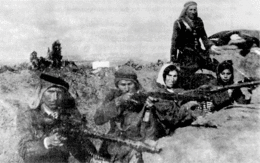
The death of al-Qassam on 20 November 1935 generated widespread outrage in the Arab community. Huge crowds accompanied Qassam's body to his grave in Haifa. A few months later, in April 1936, the Arab national general strike broke out. The strike lasted until October 1936, instigated by the Arab Higher Committee, headed by Amin al-Husseini. During the summer of that year, thousands of Jewish-farmed acres and orchards were destroyed, Jewish civilians were attacked and killed, and some Jewish communities, such as those in Beisan (Beit She'an) and Acre, fled to safer areas. (Gilbert 1998, p. 80) The violence abated for about a year while the British sent the Peel Commission to investigate. (Khalidi 2006, pp. 87–90)
During the first stages of the Arab Revolt, due to rivalry between the clans of al-Husseini and Nashashibi among the Palestinian Arabs, Raghib Nashashibi was forced to flee to Egypt after several assassination attempts ordered by Amin al-Husseini.[27]
Following the Arab rejection of the Peel Commission recommendation, the revolt resumed in autumn of 1937. Over the next 18 months, the British lost control of Nablus and Hebron. British forces, supported by 6,000 armed Jewish auxiliary police,[28] suppressed the widespread riots with overwhelming force. The British officer Charles Orde Wingate (who supported a Zionist revival for religious reasons[29]) organised Special Night Squads composed of British soldiers and Jewish volunteers such as Yigal Alon, which “scored significant successes against the Arab rebels in the lower Galilee and in the Jezreel valley” (Black 1991, p. 14) by conducting raids on Arab villages. (Shapira 1992, pp. 247, 249, 350) The Jewish militia Irgun used violence also against Arab civilians as "retaliatory acts,"[30] attacking marketplaces and buses.
By the time the revolt concluded in March 1939, more than 5,000 Arabs, 400 Jews, and 200 British had been killed and at least 15,000 Arabs were wounded.[31] The Revolt resulted in the deaths of 5,000 Palestinian Arabs and the wounding of 10,000. In total, 10% of the adult Arab male population was killed, wounded, imprisoned, or exiled. (Khalidi 2001, p. 26) From 1936 to 1945, while establishing collaborative security arrangements with the Jewish Agency, the British confiscated 13,200 firearms from Arabs and 521 weapons from Jews.[32]
The attacks on the Jewish population by Arabs had three lasting effects: firstly, they led to the formation and development of Jewish underground militias, primarily the Haganah, which were to prove decisive in 1948. Secondly, it became clear that the two communities could not be reconciled, and the idea of partition was born. Thirdly, the British responded to Arab opposition with the White Paper of 1939, which severely restricted Jewish land purchase and immigration. However, with the advent of World War II, even this reduced immigration quota was not reached. The White Paper policy itself radicalised segments of the Jewish population, who after the war would no longer cooperate with the British.
The revolt had also a negative effect on Palestinian Arab leadership, social cohesion, and military capabilities and contributed to the outcome of the 1948 War because "when the Palestinians faced their most fateful challenge in 1947–49, they were still suffering from the British repression of 1936–39, and were in effect without a unified leadership. Indeed, it might be argued that they were virtually without any leadership at all."[33]
Partition proposals
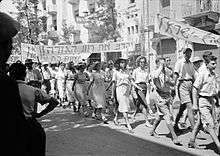
In 1937, the Peel Commission proposed a partition between a small Jewish state, whose Arab population would have to be transferred, and an Arab state to be attached to Jordan. The proposal was rejected outright by the Arabs. The two main Jewish leaders, Chaim Weizmann and David Ben-Gurion, had convinced the Zionist Congress to approve equivocally the Peel recommendations as a basis for more negotiation.[34][35][36][37][38] In a letter to his son in October 1937, Ben-Gurion explained that partition would be a first step to "possession of the land as a whole."[39][40][41] The same sentiment was recorded by Ben-Gurion on other occasions, such as at a meeting of the Jewish Agency executive in June 1938,[42] as well as by Chaim Weizmann.[41][43]
Following the London Conference (1939) the British Government published a White Paper which proposed a limit to Jewish immigration from Europe, restrictions on Jewish land purchases, and a program for creating an independent state to replace the Mandate within ten years. This was seen by the Yishuv as betrayal of the mandatory terms, especially in light of the increasing persecution of Jews in Europe. In response, Zionists organised Aliyah Bet, a program of illegal immigration into Palestine. Lehi, a small group of extremist Zionists, staged armed attacks on British authorities in Palestine. However, the Jewish Agency, which represented the mainstream Zionist leadership and most of the Jewish population, still hoped to persuade Britain to allow resumed Jewish immigration, and cooperated with Britain in World War II.
World War II
Allied and Axis activity
_George_Dobner%2C_Norm_Grainger_%5E_Reg_Shephard_at_Tel-Aviv%2C_Pales.jpg)
On 10 June 1940, Italy declared war on the British Commonwealth and sided with Germany. Within a month, the Italians attacked Palestine from the air, bombing Tel Aviv and Haifa,[44] inflicting multiple casualties.
In 1942, there was a period of great concern for the Yishuv, when the forces of German General Erwin Rommel advanced east across North Africa towards the Suez Canal and there was fear that they would conquer Palestine. This period was referred to as the "200 days of dread." This event was the direct cause for the founding, with British support, of the Palmach[45] – a highly trained regular unit belonging to Haganah (a paramilitary group which was mostly made up of reserve troops).
As in most of the Arab world, there was no unanimity amongst the Palestinian Arabs as to their position regarding the belligerents in World War II. A number of leaders and public figures saw an Axis victory as the likely outcome and a way of securing Palestine back from the Zionists and the British. Even though Arabs were not highly regarded by Nazi racial theory, the Nazis encouraged Arab support as a counter to British hegemony.[46] On the anniversary of the Balfour Declaration in 1943, SS-Reichsfuehrer Heinrich Himmler and Foreign Minister Joachim von Ribbentrop sent telegrams of support for the Grand Mufti of Jerusalem, Mohammad Amin al-Husseini to read out for a radio broadcast to a rally of supporters in Berlin.[lower-alpha 3][47] [48]
Mobilisation
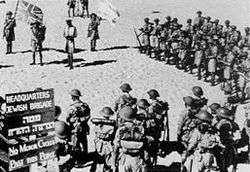
On 3 July 1944, the British government consented to the establishment of a Jewish Brigade, with hand-picked Jewish and also non-Jewish senior officers. On 20 September 1944, an official communiqué by the War Office announced the formation of the Jewish Brigade Group of the British Army. The Jewish brigade then was stationed in Tarvisio, near the border triangle of Italy, Yugoslavia, and Austria, where it played a key role in the Berihah's efforts to help Jews escape Europe for Palestine, a role many of its members would continue after the brigade was disbanded. Among its projects was the education and care of the Selvino children. Later, veterans of the Jewish Brigade became key participants of the new State of Israel's Israel Defense Forces.
From the Palestine Regiment, two platoons, one Jewish, under the command of Brigadier Ernest Benjamin, and another Arab were sent to join allied forces on the Italian Front, having taken part of final offensive there.
Besides Jews and Arabs from Palestine, in total by mid-1944 the British had assembled a multiethnic force consisting of volunteer European Jewish refugees (from German-occupied countries), Yemenite Jews and Abyssinian Jews.[49]
The Holocaust and immigration quotas
In 1939, as a consequence of the White Paper of 1939, the British reduced the number of immigrants allowed into Palestine. World War II and the Holocaust started shortly thereafter and once the 15,000 annual quota was exceeded, Jews fleeing Nazi persecution were interned in detention camps or deported to places such as Mauritius.[50]
Starting in 1939, a clandestine immigration effort called Aliya Bet was spearheaded by an organisation called Mossad LeAliyah Bet. Tens of thousands of European Jews escaped the Nazis in boats and small ships headed for Palestine. The Royal Navy intercepted many of the vessels; others were unseaworthy and were wrecked; a Haganah bomb sunk the SS Patria, killing 267 people; two other ships were sunk by Soviet submarines: the motor schooner Struma was torpedoed and sunk in the Black Sea by a Soviet submarine in February 1942 with the loss of nearly 800 lives.[51] The last refugee boats to try to reach Palestine during the war were the Bulbul, Mefküre and Morina in August 1944. A Soviet submarine sank the motor schooner Mefküre by torpedo and shellfire and machine-gunned survivors in the water,[52] killing between 300 and 400 refugees.[53] Illegal immigration resumed after World War II.
After the war 250,000 Jewish refugees were stranded in displaced persons (DP) camps in Europe. Despite the pressure of world opinion, in particular the repeated requests of US President Harry S. Truman and the recommendations of the Anglo-American Committee of Inquiry that 100,000 Jews be immediately granted entry to Palestine, the British maintained the ban on immigration.
Beginning of Zionist insurgency
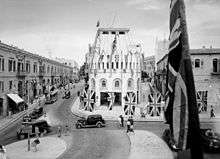
The Jewish Lehi (Fighters for the Freedom of Israel) and Irgun (National Military Organisation) movements initiated violent uprisings against the British Mandate in the 1940s. On 6 November 1944, Eliyahu Hakim and Eliyahu Bet Zuri (members of Lehi) assassinated Lord Moyne in Cairo. Moyne was the British Minister of State for the Middle East and the assassination is said by some to have turned British Prime Minister Winston Churchill against the Zionist cause. After the assassination of Lord Moyne, the Haganah kidnapped, interrogated, and turned over to the British many members of the Irgun ("The Hunting Season"), and the Jewish Agency Executive decided on a series of measures against "terrorist organisations" in Palestine.[54] Irgun ordered its members not to resist or retaliate with violence, so as to prevent a civil war.
After World War II: Insurgency and the Partition Plan
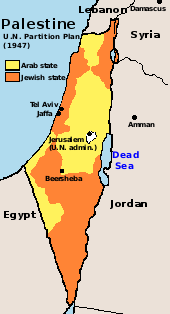
The three main Jewish underground forces later united to form the Jewish Resistance Movement and carry out several attacks and bombings against the British administration. In 1946, the Irgun blew up the King David Hotel in Jerusalem, the headquarters of the British administration, killing 92 people. Following the bombing, the British Government began interning illegal Jewish immigrants in Cyprus. In 1948 the Lehi assassinated the UN mediator Count Bernadotte in Jerusalem. Yitzak Shamir, future prime minister of Israel was one of the conspirators.
The negative publicity resulting from the situation in Palestine caused the Mandate to become widely unpopular in Britain, and caused the United States Congress to delay granting the British vital loans for reconstruction. The British Labour party had promised before its election in 1945 to allow mass Jewish migration into Palestine but reneged on this promise once in office. Anti-British Jewish militancy increased and the situation required the presence of over 100,000 British troops in the country. Following the Acre Prison Break and the retaliatory hanging of British Sergeants by the Irgun, the British announced their desire to terminate the mandate and to withdraw by no later than the beginning of August 1948.[55]
The Anglo-American Committee of Inquiry in 1946 was a joint attempt by Britain and the United States to agree on a policy regarding the admission of Jews to Palestine. In April, the Committee reported that its members had arrived at a unanimous decision. The Committee approved the American recommendation of the immediate acceptance of 100,000 Jewish refugees from Europe into Palestine. It also recommended that there be no Arab, and no Jewish State. The Committee stated that "in order to dispose, once and for all, of the exclusive claims of Jews and Arabs to Palestine, we regard it as essential that a clear statement of principle should be made that Jew shall not dominate Arab and Arab shall not dominate Jew in Palestine." U.S. President Harry S Truman angered the British Government by issuing a statement supporting the 100,000 refugees but refusing to acknowledge the rest of the committee's findings. Britain had asked for U.S assistance in implementing the recommendations. The U.S. War Department had said earlier that to assist Britain in maintaining order against an Arab revolt, an open-ended U.S. commitment of 300,000 troops would be necessary. The immediate admission of 100,000 new Jewish immigrants would almost certainly have provoked an Arab uprising.[56]
These events were the decisive factors that forced Britain to announce their desire to terminate the Palestine Mandate and place the Question of Palestine before the United Nations, the successor to the League of Nations. The UN created UNSCOP (the UN Special Committee on Palestine) on 15 May 1947, with representatives from 11 countries. UNSCOP conducted hearings and made a general survey of the situation in Palestine, and issued its report on 31 August. Seven members (Canada, Czechoslovakia, Guatemala, Netherlands, Peru, Sweden, and Uruguay) recommended the creation of independent Arab and Jewish states, with Jerusalem to be placed under international administration. Three members (India, Iran, and Yugoslavia) supported the creation of a single federal state containing both Jewish and Arab constituent states. Australia abstained.[57]
On 29 November 1947, the UN General Assembly, voting 33 to 13, with 10 abstentions, adopted a resolution recommending the adoption and implementation of the Plan of Partition with Economic Union as Resolution 181 (II).,[58][59] while making some adjustments to the boundaries between the two states proposed by it. The division was to take effect on the date of British withdrawal. The partition plan required that the proposed states grant full civil rights to all people within their borders, regardless of race, religion or gender. The UN General Assembly is only granted the power to make recommendations, therefore, UNGAR 181 was not legally binding.[60] Both the U.S. and the Soviet Union supported the resolution. Haiti, Liberia, and the Philippines changed their votes at the last moment after concerted pressure from the U.S. and from Zionist organisations.[61][62][63] The five members of the Arab League, who were voting members at the time, voted against the Plan.
The Jewish Agency, which was the Jewish state-in-formation, accepted the plan, and nearly all the Jews in Palestine rejoiced at the news.
The partition plan was rejected out of hand by Palestinian Arab leadership and by most of the Arab population.[lower-alpha 4][lower-alpha 5] Meeting in Cairo on November and December 1947, the Arab League then adopted a series of resolutions endorsing a military solution to the conflict.
Britain announced that it would accept the partition plan, but refused to enforce it, arguing it was not accepted by the Arabs. Britain also refused to share the administration of Palestine with the UN Palestine Commission during the transitional period. In September 1947, the British government announced that the Mandate for Palestine would end at midnight on 14 May 1948.[66][67][68]
Some Jewish organisations also opposed the proposal. Irgun leader Menachem Begin announced, "The partition of the Homeland is illegal. It will never be recognised. The signature by institutions and individuals of the partition agreement is invalid. It will not bind the Jewish people. Jerusalem was and will forever be our capital. Eretz Israel will be restored to the people of Israel. All of it. And for ever."[69]
Termination of the mandate

When the UK announced the independence of Transjordan in 1946, the final Assembly of the League of Nations and the General Assembly both adopted resolutions welcoming the news.[70] The Jewish Agency objected, claiming that Transjordan was an integral part of Palestine, and that according to Article 80 of the UN Charter, the Jewish people had a secured interest in its territory.[71]
During the General Assembly deliberations on Palestine, there were suggestions that it would be desirable to incorporate part of Transjordan's territory into the proposed Jewish state. A few days before the adoption of Resolution 181 (II) on 29 November 1947, U.S. Secretary of State Marshall noted frequent references had been made by the Ad Hoc Committee regarding the desirability of the Jewish State having both the Negev and an "outlet to the Red Sea and the Port of Aqaba."[72] According to John Snetsinger, Chaim Weizmann visited President Truman on 19 November 1947 and said it was imperative that the Negev and Port of Aqaba be under Jewish control and that they be included in the Jewish state.[73] Truman telephoned the US delegation to the UN and told them he supported Weizmann's position.[74] However, the Trans-Jordan memorandum excluded territories of the Emirate of Transjordan from any Jewish settlement.[75]
Immediately after the UN resolution, the 1947-1948 Civil War in Mandatory Palestine broke out between the Arab and Jewish communities, and British authority began to break down. On 16 December 1947, the Palestine Police Force withdrew from the Tel Aviv area, home to more than half the Jewish population, and turned over responsibility for the maintenance of law and order to Jewish police.[76] As the civil war raged on, British military forces gradually withdrew from Palestine, although they occasionally intervened in favour of either side. As they withdrew, they handed over control to local authorities and locally raised police forces were charged with maintaining law and order. The areas they withdrew from often quickly became war zones. The British maintained strong presences in Jerusalem and Haifa, even as Jerusalem came under siege by Arab forces and became the scene of fierce fighting, though the British occasionally intervened in the fighting, largely to secure their evacuation routes, including by proclaiming martial law and enforcing truces. The Palestine Police Force was largely inoperative, and government services such as social welfare, control of water supplies, and postal services were withdrawn. In March 1948, all British judges in Palestine were sent back to Britain.[77] In April 1948, the British withdrew from most of Haifa but retained an enclave in the port area to be used in the evacuation of British forces, and temporarily retained RAF Ramat David airbase to cover their retreat, leaving behind a volunteer police force to maintain order. The city was quickly captured by the Haganah in the Battle of Haifa. Following the victory, British forces in Jerusalem announced that they had no intention of assuming control of any local administrations, but would not permit any actions that would hamper the safe and orderly withdrawal of British forces from Palestine, and would set up military courts to try persons who interfered.[78][79][80] Although by this time British authority in most of Palestine had broken down, with most of the country in control of the Jews and Arabs, the British air and sea blockade of Palestine remained firmly in place. Although Arab volunteers were able to cross the borders between Palestine and the surrounding Arab states to join the fighting, the British did not allow the regular armies of the surrounding Arab states to cross into Palestine.
The British had notified the U.N. of their intent to terminate the mandate not later than 1 August 1948.[81][82] However, early in 1948, the United Kingdom announced its firm intention to end its mandate in Palestine on 15 May. In response, President Harry S Truman made a statement on 25 March proposing UN trusteeship rather than partition, stating that "unfortunately, it has become clear that the partition plan cannot be carried out at this time by peaceful means... unless emergency action is taken, there will be no public authority in Palestine on that date capable of preserving law and order. Violence and bloodshed will descend upon the Holy Land. Large-scale fighting among the people of that country will be the inevitable result."[83]
_-_Hoisting_of_the_national_flag_during_a_special_ceremony_of_elementary_school_children.jpg)
By 14 May 1948, the only British forces remaining in Palestine were in the Haifa area and in Jerusalem. On that same day, the British garrison in Jerusalem withdrew, and High Commissioner Alan Cunningham left the city for Haifa, where he was to leave the country by sea. The Jewish Leadership, led by future Prime Minister, David Ben-Gurion, declared the establishment of a Jewish State in Eretz-Israel, to be known as the State of Israel,[84] on the afternoon of 14 May 1948 (5 Iyar 5708 in the Hebrew calendar), to come into force at midnight of that day.[85][86][87] On the same day, the Provisional Government of Israel asked the US Government for recognition, on the frontiers specified in the UN Plan for Partition.[88] The United States immediately replied, recognizing "the provisional government as the de facto authority."[89]
At midnight on 14/15 May 1948, the Mandate for Palestine expired and the State of Israel came into being. The Palestine Government formally ceased to exist, the status of British forces still in the process of withdrawal from Haifa changed to occupiers of foreign territory, the Palestine Police Force formally stood down and was disbanded, with the remaining personnel evacuated alongside British military forces, the British blockade of Palestine was lifted, and all those who had been Palestinian citizens ceased to be British protected persons, with Mandatory Palestine passports no longer giving British protection.[79][90] The 1948 Palestinian exodus occurred in the period leading up to the end of the Mandate and subsequently.[91][92][93]
Over the next few days, approximately 700 Lebanese, 1,876 Syrian, 4,000 Iraqi, 2,800 Egyptian troops crossed over the borders and into Palestine, starting the 1948 Arab-Israeli War.[94] Around 4,500 Transjordanian troops, commanded partly by 38 British officers who had resigned their commissions in the British army only weeks earlier, including overall commander, General John Bagot Glubb, entered the Corpus separatum region encompassing Jerusalem and its environs (in response to the Haganah's Operation Kilshon)[95] and moved into areas designated as part of the Arab state by the UN partition plan. The war, which was to last until 1949, would see Israel expand to encompass about 78% of the territory of the former British Mandate, with Jordan seizing and subsequently annexing the West Bank and Egypt seizing the Gaza Strip. With the end of the Mandate, the remaining British troops in Israel were concentrated in an enclave in the Haifa port area through which they were being withdrawn and RAF Ramat David, which was maintained to cover the withdrawal. The British handed over RAF Ramat David to the Israelis on 26 May, and the last British forces were evacuated from Haifa on 30 June.
Politics
Palestinian Arab community
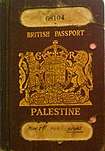

The resolution of the San Remo Conference contained a safeguarding clause for the existing rights of the non-Jewish communities. The conference accepted the terms of the Mandate with reference to Palestine, on the understanding that there was inserted in the memorandum a legal undertaking by the Mandatory Power that it would not involve the surrender of the rights hitherto enjoyed by the non-Jewish communities in Palestine.[96] The draft mandates for Mesopotamia and Palestine, and all of the post-war peace treaties contained clauses for the protection of religious groups and minorities. The mandates invoked the compulsory jurisdiction of the Permanent Court of International Justice in the event of any disputes.[97]
Article 62 (LXII) of the Treaty of Berlin, 13 July 1878[98] dealt with religious freedom and civil and political rights in all parts of the Ottoman Empire.[99] The guarantees have frequently been referred to as "religious rights" or "minority rights." However, the guarantees included a prohibition against discrimination in civil and political matters. Difference of religion could not be alleged against any person as a ground for exclusion or incapacity in matters relating to the enjoyment of civil or political rights, admission to public employments, functions, and honours, or the exercise of the various professions and industries, "in any locality whatsoever."
A legal analysis performed by the International Court of Justice noted that the Covenant of the League of Nations had provisionally recognised the communities of Palestine as independent nations. The mandate simply marked a transitory period, with the aim and object of leading the mandated territory to become an independent self-governing State.[100] Judge Higgins explained that the Palestinian people are entitled to their territory, to exercise self-determination, and to have their own State."[101] The Court said that specific guarantees regarding freedom of movement and access to the Holy Sites contained in the Treaty of Berlin (1878) had been preserved under the terms of the Palestine Mandate and a chapter of the United Nations Partition Plan for Palestine.[102]
According to historian Rashid Khalidi, the mandate ignored the political rights of the Arabs.[103] The Arab leadership repeatedly pressed the British to grant them national and political rights, such as representative government, over Jewish national and political rights in the remaining 23% of the Mandate of Palestine which the British had set aside for a Jewish homeland. The Arabs reminded the British of President Wilson's Fourteen Points and British promises during the First World War. The British however made acceptance of the terms of the mandate a precondition for any change in the constitutional position of the Arabs. A legislative council was proposed in The Palestine Order in Council, of 1922 which implemented the terms of the mandate. It stated that: "No Ordinance shall be passed which shall be in any way repugnant to or inconsistent with the provisions of the Mandate." For the Arabs, this was unacceptable, as they felt that this would be "self murder."[104] As a result, the Arabs boycotted the elections to the Council held in 1923, which were subsequently annulled.[105] During the whole interwar period, the British, appealing to the terms of the mandate, which they had designed themselves, rejected the principle of majority rule or any other measure that would give an Arab majority control over the government of Palestine.[106]
The terms of the mandate required the establishment of self-governing institutions in both Palestine and Transjordan. In 1947, Foreign Secretary Bevin admitted that during the previous twenty-five years the British had done their best to further the legitimate aspirations of the Jewish communities without prejudicing the interests of the Arabs, but had failed to "secure the development of self-governing institutions" in accordance with the terms of the Mandate.[107]
Palestinian Arab leadership and national aspirations
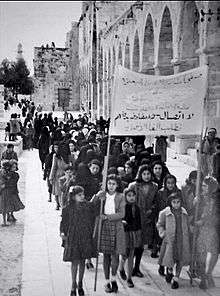
Under the British Mandate, the office of "Mufti of Jerusalem," traditionally limited in authority and geographical scope, was refashioned into that of "Grand Mufti of Palestine." Furthermore, a Supreme Muslim Council (SMC) was established and given various duties, such as the administration of religious endowments and the appointment of religious judges and local muftis. In Ottoman times, these duties had been fulfilled by the bureaucracy in Istanbul. (Khalidi 2006, p. 63) In dealings with the Palestinian Arabs, the British negotiated with the elite rather than the middle or lower classes.(Khalidi 2006, p. 52) They chose Hajj Amin al-Husseini to become Grand Mufti, although he was young and had received the fewest votes from Jerusalem's Islamic leaders. (Khalidi 2006, pp. 56–57) One of the mufti's rivals, Raghib Bey al-Nashashibi, had already been appointed mayor of Jerusalem in 1920, replacing Musa Kazim, whom the British removed after the Nabi Musa riots of 1920, (Khalidi 2006, pp. 63, 69)(Segev 2000, pp. 127–144) during which he exhorted the crowd to give their blood for Palestine. (Morris 2001, p. 112) During the entire Mandate period, but especially during the latter half, the rivalry between the mufti and al-Nashashibi dominated Palestinian politics. Khalidi ascribes the failure of the Palestinian leaders to enroll mass support, because of their experiences during the Ottoman Empire period, as they were then part of the ruling elite and accustomed to their commands being obeyed. The idea of mobilising the masses was thoroughly alien to them. (Khalidi 2006, p. 81)
On the Husseini-Nashashibi rivalry, an editorial in the Arabic-language Falastin newspaper in the 1920s commented:[109]
The spirit of factionalism has penetrated most levels of society; one can see it among journalists, trainees, and the rank and file. If you ask anyone: who does he support? He will reply with pride, Husseini or Nashasibi, or. . . he will start to pour out his wrath against the opposing camp in a most repulsive manner.
There had already been rioting and attacks on and massacres of Jews in 1921 and 1929. During the 1930s, Palestinian Arab popular discontent with Jewish immigration grew. In the late 1920s and early 1930s, several factions of Palestinian society, especially from the younger generation, became impatient with the internecine divisions and ineffectiveness of the Palestinian elite and engaged in grass-roots anti-British and anti-Zionist activism, organised by groups such as the Young Men's Muslim Association. There was also support for the radical nationalist Independence Party (Hizb al-Istiqlal), which called for a boycott of the British in the manner of the Indian Congress Party. Some took to the hills to fight the British and the Jews. Most of these initiatives were contained and defeated by notables in the pay of the Mandatory Administration, particularly the mufti and his cousin Jamal al-Husseini. A six-month general strike in 1936 marked the start of the great Arab Revolt. (Khalidi 2006, pp. 87–90)
Jewish community
The conquest of the Ottoman Syria by the British forces in 1917, found a mixed community in the region, with Palestine, the southern part of the Ottoman Syria, containing a mixed population of Muslims, Christians, Jews and Druze. In this period, the Jewish community (Yishuv) in Palestine was composed of traditional Jewish communities in cities (the Old Yishuv), which had existed for centuries,[110] and the newly established agricultural Zionist communities (the New Yishuv), established since the 1870s. With the establishment of the Mandate, the Jewish community in Palestine formed the Zionist Commission to represent its interests.
In 1929, the Jewish Agency for Palestine took over from the Zionist Commission its representative functions and administration of the Jewish community. During the Mandate period, the Jewish Agency was a quasi-governmental organisation that served the administrative needs of the Jewish community. Its leadership was elected by Jews from all over the world by proportional representation.[111] The Jewish Agency was charged with facilitating Jewish immigration to Palestine, land purchase and planning the general policies of the Zionist leadership. It ran schools and hospitals, and formed the Haganah. The British authorities offered to create a similar Arab Agency but this offer was rejected by Arab leaders.[112]
In response to numerous Arab attacks on Jewish communities, the Haganah, a Jewish paramilitary organisation, was formed on 15 June 1920 to defend Jewish residents. Tensions led to widespread violent disturbances on several occasions, notably in 1921 (see Jaffa riots), 1929 (primarily violent attacks by Arabs on Jews—see 1929 Hebron massacre) and 1936–1939. Beginning in 1936, Jewish groups such as Etzel (Irgun) and Lehi (Stern Gang) conducted campaigns of violence against British military and Arab targets.
Jewish immigration
.jpg)
During the Mandate, the Yishuv or Jewish community in Palestine, grew from one-sixth to almost one-third of the population. According to official records, 367,845 Jews and 33,304 non-Jews immigrated legally between 1920 and 1945.[113] It was estimated that another 50–60,000 Jews and a marginal number of Arabs, the latter mostly on a seasonal basis, immigrated illegally during this period.[114] Immigration accounted for most of the increase of Jewish population, while the non-Jewish population increase was largely natural.[115] Of the Jewish immigrants, in 1939 most had come from Germany and Czechoslovakia, but in 1940–1944 most came from Romania and Poland, with an additional 3,530 immigrants arriving from Yemen during the same period.[116]
Initially, Jewish immigration to Palestine met little opposition from the Palestinian Arabs. However, as anti-Semitism grew in Europe during the late 19th and early 20th centuries, Jewish immigration (mostly from Europe) to Palestine began to increase markedly. Combined with the growth of Arab nationalism in the region and increasing anti-Jewish sentiments the growth of Jewish population created much Arab resentment. The British government placed limitations on Jewish immigration to Palestine. These quotas were controversial, particularly in the latter years of British rule, and both Arabs and Jews disliked the policy, each for their own reasons.
Jewish immigrants were to be afforded Palestinian citizenship:
Article 7. The Administration of Palestine shall be responsible for enacting a nationality law. There shall be included in this law provisions framed so as to facilitate the acquisition of Palestinian citizenship by Jews who take up their permanent residence in Palestine.[117]
Jewish national home
In 1919, the General Secretary (and future President) of the Zionist Organisation, Nahum Sokolow, published History of Zionism (1600–1918). He also represented the Zionist Organisation at the Paris Peace Conference.
The object of Zionism is to establish for the Jewish people a home in Palestine secured by public law." ... It has been said and is still being obstinately repeated by anti-Zionists again and again, that Zionism aims at the creation of an independent "Jewish State" But this is fallacious. The "Jewish State" was never part of the Zionist programme. The Jewish State was the title of Herzl's first pamphlet, which had the supreme merit of forcing people to think. This pamphlet was followed by the first Zionist Congress, which accepted the Basle programme—the only programme in existence.
— Nahum Sokolow, History of Zionism[118]
One of the objectives of British administration was to give effect to the Balfour Declaration of 1917, which was also set out in the preamble of the mandate, as follows:
Whereas the Principal Allied Powers have also agreed that the Mandatory should be responsible for putting into effect the declaration originally made on November 2nd, 1917, by the Government of His Britannic Majesty, and adopted by the said Powers, in favour of the establishment in Palestine of a national home for the Jewish people, it being clearly understood that nothing should be done which might prejudice the civil and religious rights of existing non-Jewish communities in Palestine, or the rights and political status enjoyed by Jews in any other country.[119]
The United Nations Special Committee on Palestine said the Jewish National Home, which derived from the formulation of Zionist aspirations in the 1897 Basle program has provoked many discussions concerning its meaning, scope and legal character, especially since it had no known legal connotation and there are no precedents in international law for its interpretation. It was used in the Balfour Declaration and in the Mandate, both of which promised the establishment of a "Jewish National Home" without, however, defining its meaning. A statement on "British Policy in Palestine," issued on 3 June 1922 by the Colonial Office, placed a restrictive construction upon the Balfour Declaration. The statement included "the disappearance or subordination of the Arabic population, language or customs in Palestine" or "the imposition of Jewish nationality upon the inhabitants of Palestine as a whole," and made it clear that in the eyes of the mandatory Power, the Jewish National Home was to be founded in Palestine and not that Palestine as a whole was to be converted into a Jewish National Home. The Committee noted that the construction, which restricted considerably the scope of the National Home, was made prior to the confirmation of the Mandate by the Council of the League of Nations and was formally accepted at the time by the Executive of the Zionist Organisation.[120]
In March 1930, Lord Passfield, the Secretary of State for the Colonies, had written a Cabinet Paper[121] which said:
In the Balfour Declaration there is no suggestion that the Jews should be accorded a special or favoured position in Palestine as compared with the Arab inhabitants of the country, or that the claims of Palestinians to enjoy self-government (subject to the rendering of administrative advice and assistance by a Mandatory as foreshadowed in Article XXII of the Covenant) should be curtailed in order to facilitate the establishment in Palestine of a National Home for the Jewish people." ... Zionist leaders have not concealed and do not conceal their opposition to the grant of any measure of self-government to the people of Palestine either now or for many years to come. Some of them even go so far as to claim that that provision of Article 2 of the Mandate constitutes a bar to compliance with the demand of the Arabs for any measure of self-government. In view of the provisions of Article XXII of the Covenant and of the promises made to the Arabs on several occasions that claim is inadmissible.
The League of Nations Permanent Mandates Commission took the position that the Mandate contained a dual obligation. In 1932 the Mandates Commission questioned the representative of the Mandatory on the demands made by the Arab population regarding the establishment of self-governing institutions, in accordance with various articles of the mandate, and in particular Article 2. The Chairman noted that "under the terms of the same article, the mandatory Power had long since set up the Jewish National Home."[122]
In 1937, the Peel Commission, a British Royal Commission headed by Earl Peel, proposed solving the Arab–Jewish conflict by partitioning Palestine into two states. The two main Jewish leaders, Chaim Weizmann and David Ben-Gurion, had convinced the Zionist Congress to approve equivocally the Peel recommendations as a basis for more negotiation.[34][35][36][123] The US Consul General at Jerusalem told the State Department that the Mufti had refused the principle of partition and declined to consider it. The Consul said that the Emir Abdullah urged acceptance on the ground that realities must be faced, but wanted modification of the proposed boundaries and Arab administrations in the neutral enclave. The Consul also noted that Nashashibi sidestepped the principle, but was willing to negotiate for favourable modifications.[124]
A collection of private correspondence published by David Ben Gurion contained a letter written in 1937 which explained that he was in favour of partition because he didn't envision a partial Jewish state as the end of the process. Ben Gurion wrote "What we want is not that the country be united and whole, but that the united and whole country be Jewish." He explained that a first-class Jewish army would permit Zionists to settle in the rest of the country with or without the consent of the Arabs.[125] Benny Morris said that both Chaim Weizmann and David Ben Gurion saw partition as a stepping stone to further expansion and the eventual takeover of the whole of Palestine.[126] Former Israeli Foreign Minister and historian Schlomo Ben Ami writes that 1937 was the same year that the "Field Battalions" under Yitzhak Sadeh wrote the "Avner Plan," which anticipated and laid the groundwork for what would become in 1948, Plan D. It envisioned going far beyond any boundaries contained in the existing partition proposals and planned the conquest of the Galilee, the West Bank, and Jerusalem.[127]
In 1942, the Biltmore Program was adopted as the platform of the World Zionist Organisation. It demanded "that Palestine be established as a Jewish Commonwealth."
In 1946 an Anglo-American Committee of Inquiry noted that the demand for a Jewish State went beyond the obligations of either the Balfour Declaration or the Mandate and had been expressly disowned by the Chairman of the Jewish Agency as recently as 1932.[128] The Jewish Agency subsequently refused to accept the subsequent Morrison-Grady Plan as the basis for discussion. A spokesman for the agency, Eliahu Epstein, told the US State Department that the Agency could not attend the London conference if the Grady-Morrison proposal was on the agenda. He stated that the Agency was unwilling to be placed in a position where it might have to compromise between the Grady-Morrison proposals on the one hand and its own partition plan on the other. He stated that the Agency had accepted partition as the solution for Palestine which it favoured.[129]
Land ownership
.jpg)
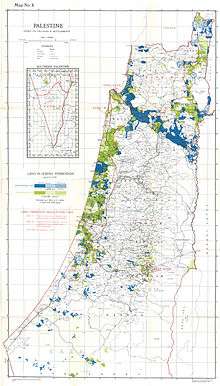
After transition to the British rule, much of the agricultural land in Palestine (about one third of the whole territory) was still owned by the same landowners as under Ottoman rule, mostly powerful Arab clans and local Muslim sheikhs. Other lands had been held by foreign Christian organisations (most notably the Greek Orthodox Church), as well as Jewish private and Zionist organisations, and to lesser degree by small minorities of Bahai's, Samaritans and Circassians.
As of 1931, the territory of the British Mandate of Palestine was 26,625,600 dunams (26,625.6 km2), of which 8,252,900 dunams (8,252.9 km2) or 33% were arable.[130] Official statistics show that Jews privately and collectively owned 1,393,531 dunams (1,393.53 km2), or 5.23% of Palestine's total in 1945.[131][132] The Jewish owned agricultural land was largely located in the Galilee and along the coastal plain. Estimates of the total volume of land that Jews had purchased by 15 May 1948 are complicated by illegal and unregistered land transfers, as well as by the lack of data on land concessions from the Palestine administration after 31 March 1936. According to Avneri, Jews held 1,850,000 dunams (1,850 km2) of land in 1947, or 6.94% of the total.[133] Stein gives the estimate of 2,000,000 dunams (2,000 km2) as of May 1948, or 7.51% of the total.[134] According to Fischbach, By 1948, Jews and Jewish companies owned 20% percent of all cultivable land in the country.[135]
Nevertheless, the amount of land owned by Jews is easier to calculate than that owned by Arabs. It is difficult to reckon the total amount of land owned by Arabs (Muslim, Christian and Druze) in Mandatory Palestine. The 1945 UN estimate shows that Arab ownership of arable land was on average 68% of a district, ranging from 15% ownership in the Beer-Sheba district to 99% ownership in the Ramallah district. These data cannot be fully understood without comparing them to those of neighbouring countries: in Iraq, for instance, still in 1951 only 0.3 per cent of registered land (or 50 per cent of the total amount) was categorised as ‘private property’.[136]
Land ownership by district
The following table shows the 1945 land ownership of mandatory Palestine by district:
| District | Sub-district | Arab-owned | Jewish-owned | Public / other | ||
|---|---|---|---|---|---|---|
| Haifa | Haifa | 42% | 35% | 23% | ||
| Galilee | Acre | 87% | 3% | 10% | ||
| Beisan | 44% | 34% | 22% | |||
| Nazareth | 52% | 28% | 20% | |||
| Safad | 68% | 18% | 14% | |||
| Tiberias | 51% | 38% | 11% | |||
| Lydda | Jaffa | 47% | 39% | 14% | ||
| Ramle | 77% | 14% | 9% | |||
| Samaria | Jenin | 84% | <1% | 16% | ||
| Nablus | 87% | <1% | 13% | |||
| Tulkarm | 78% | 17% | 5% | |||
| Jerusalem | Hebron | 96% | <1% | 4% | ||
| Jerusalem | 84% | 2% | 14% | |||
| Ramallah | 99% | <1% | 1% | |||
| Gaza | Beersheba | 15% | <1% | 85% | ||
| Gaza | 75% | 4% | 21% | |||
| Data from the Land Ownership of Palestine[137] | ||||||
Land ownership by corporation
The table below shows the land ownership of Palestine by large Jewish Corporations (in square kilometres) on 31 December 1945.
| Corporations | Area | |||||
|---|---|---|---|---|---|---|
| JNF | 660.10 | |||||
| PICA | 193.70 | |||||
| Palestine Land Development Co. Ltd. | 9.70 | |||||
| Hemnuta Ltd | 16.50 | |||||
| Africa Palestine Investment Co. Ltd. | 9.90 | |||||
| Bayside Land Corporation Ltd. | 8.50 | |||||
| Palestine Kupat Am. Bank Ltd. | 8.40 | |||||
| Total | 906.80 | |||||
| Data is from Survey of Palestine (vol. I, p. 245).[138][139] | ||||||
Land ownership by type
The land owned privately and collectively by Jews, Arabs and other non-Jews can be classified as urban, rural built-on, cultivable (farmed), and uncultivable. The following chart shows the ownership by Jews, Arabs and other non-Jews in each of the categories.
| Category | Arab / non-Jewish ownership | Jewish ownership | Total | |||
|---|---|---|---|---|---|---|
| Urban | 76.66 | 70.11 | 146.77 | |||
| Rural built-on | 36.85 | 42.33 | 79.18 | |||
| Cereal (taxable) | 5,503.18 | 814.10 | 6,317.29 | |||
| Cereal (not taxable) | 900.29 | 51.05 | 951.34 | |||
| Plantation | 1,079.79 | 95.51 | 1,175.30 | |||
| Citrus | 145.57 | 141.19 | 286.76 | |||
| Banana | 2.30 | 1.43 | 3.73 | |||
| Uncultivable | 16,925.81 | 298.52 | 17,224.33 | |||
| Total | 24,670.46 | 1,514.25 | 26,184.70 | |||
| Data is from Survey of Palestine (vol. II, p. 566).[139][140] By the end of 1946, Jewish ownership had increased to 1624 km2.[141] | ||||||
List of Mandatory land laws
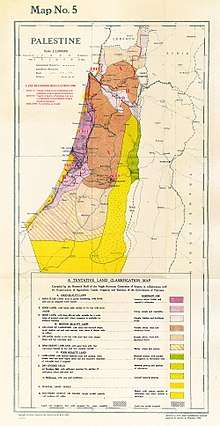
- Land Transfer Ordinance of 1920
- 1926 Correction of Land Registers Ordinance
- Land Settlement Ordinance of 1928
- Land Transfer Regulations of 1940
In February 1940, the British Government of Palestine promulgated the Land Transfer Regulations which divided Palestine into three regions with different restrictions on land sales applying to each. In Zone "A," which included the hill-country of Judea as a whole, certain areas in the Jaffa sub-District, and in the Gaza District, and the northern part of the Beersheba sub-District, new agreements for sale of land other than to a Palestinian Arab were forbidden without the High Commissioner's permission. In Zone "B," which included the Jezreel Valley, eastern Galilee, a parcel of coastal plain south of Haifa, a region northeast of the Gaza District, and the southern part of the Beersheba sub-District, sale of land by a Palestinian Arab was forbidden except to a Palestinian Arab with similar exceptions. In the "free zone," which consisted of Haifa Bay, the coastal plain from Zikhron Ya'akov to Yibna, and the neighbohood of Jerusalem, there were no restrictions. The reason given for the regulations was that the Mandatory was required to "ensur[e] that the rights and positions of other sections of the population are not prejudiced," and an assertion that "such transfers of land must be restricted if Arab cultivators are to maintain their existing standard of life and a considerable landless Arab population is not soon to be created"[142]
Demographics
British censuses and estimations
.jpeg)
In 1920, the majority of the approximately 750,000 people in this multi-ethnic region were Arabic-speaking Muslims, including a Bedouin population (estimated at 103,331 at the time of the 1922 census[143] and concentrated in the Beersheba area and the region south and east of it), as well as Jews (who comprised some 11% of the total) and smaller groups of Druze, Syrians, Sudanese, Somalis, Circassians, Egyptians, Copts, Greeks, and Hejazi Arabs.
- The first census of 1922 showed a population of 757,182, of whom 78% were Muslim, 11% Jewish and 10% Christian.
- The second census, of 1931, gave a total population of 1,035,154 of whom 73.4% were Muslim, 16.9% Jewish and 8.6% Christian.
A discrepancy between the two censuses and records of births, deaths and immigration, led the authors of the second census to postulate the illegal immigration of about 9,000 Jews and 4,000 Arabs during the intervening years.[144]
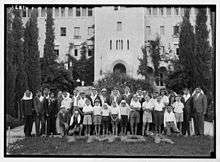
There were no further censuses but statistics were maintained by counting births, deaths and migration. By the end of 1936 the total population was approximately 1,300,000, the Jews being estimated at 384,000. The Arabs had also increased their numbers rapidly, mainly as a result of the cessation of the military conscription imposed on the country by the Ottoman Empire, the campaign against malaria and a general improvement in health services. In absolute figures their increase exceeded that of the Jewish population, but proportionally, the latter had risen from 13 per cent of the total population at the census of 1922 to nearly 30 per cent at the end of 1936.[145]
Some components such as illegal immigration could only be estimated approximately. The White Paper of 1939, which placed immigration restrictions on Jews, stated that the Jewish population "has risen to some 450,000" and was "approaching a third of the entire population of the country." In 1945, a demographic study showed that the population had grown to 1,764,520, comprising 1,061,270 Muslims, 553,600 Jews, 135,550 Christians and 14,100 people of other groups.
| Year | Total | Muslim | Jewish | Christian | Other |
|---|---|---|---|---|---|
| 1922 | 752,048 | 589,177 (78%) | 83,790 (11%) | 71,464 (10%) | 7,617 (1%) |
| 1931 | 1,036,339 | 761,922 (74%) | 175,138 (17%) | 89,134 (9%) | 10,145 (1%) |
| 1945 | 1,764,520 | 1,061,270 (60%) | 553,600 (31%) | 135,550 (8%) | 14,100 (1%) |
| Average compounded population growth rate per annum, 1922–1945 |
3.8% | 2.6% | 8.6% | 2.8% | 2.7% |
By district
The following table gives the religious demography of each of the 16 districts of the Mandate in 1945.
| Demography of Palestine in 1945 by district[146] | ||||||||
|---|---|---|---|---|---|---|---|---|
| District | Sub-District | Muslim | Percentage | Jewish | Percentage | Christian | Percentage | Total |
| Haifa | Haifa | 95,970 | 38% | 119,020 | 47% | 33,710 | 13% | 253,450 |
| Galilee | Acre | 51,130 | 69% | 3,030 | 4% | 11,800 | 16% | 73,600 |
| Beisan | 16,660 | 67% | 7,590 | 30% | 680 | 3% | 24,950 | |
| Nazareth | 30,160 | 60% | 7,980 | 16% | 11,770 | 24% | 49,910 | |
| Safad | 47,310 | 83% | 7,170 | 13% | 1,630 | 3% | 56,970 | |
| Tiberias | 23,940 | 58% | 13,640 | 33% | 2,470 | 6% | 41,470 | |
| Lydda | Jaffa | 95,980 | 24% | 295,160 | 72% | 17,790 | 4% | 409,290 |
| Ramle | 95,590 | 71% | 31,590 | 24% | 5,840 | 4% | 134,030 | |
| Samaria | Jenin | 60,000 | 98% | negligible | <1% | 1,210 | 2% | 61,210 |
| Nablus | 92,810 | 98% | negligible | <1% | 1,560 | 2% | 94,600 | |
| Tulkarm | 76,460 | 82% | 16,180 | 17% | 380 | 1% | 93,220 | |
| Jerusalem | Hebron | 92,640 | 99% | 300 | <1% | 170 | <1% | 93,120 |
| Jerusalem | 104,460 | 41% | 102,520 | 40% | 46,130 | 18% | 253,270 | |
| Ramallah | 40,520 | 83% | negligible | <1% | 8,410 | 17% | 48,930 | |
| Gaza | Beersheba | 6,270 | 90% | 510 | 7% | 210 | 3% | 7,000 |
| Gaza | 145,700 | 97% | 3,540 | 2% | 1,300 | 1% | 150,540 | |
| Total | 1,076,780 | 58% | 608,230 | 33% | 145,060 | 9% | 1,845,560 | |
Government and institutions
Under the terms of the August 1922 Palestine Order in Council, the Mandate territory was divided into administrative regions known as districts and administer by the office of the British High Commissioner for Palestine.[147]
Britain continued the millet system of the Ottoman Empire whereby all matters of a religious nature and personal status were within the jurisdiction of Muslim courts and the courts of other recognised religions, called confessional communities. The High Commissioner established the Orthodox Rabbinate and retained a modified millet system which only recognised eleven religious communities: Muslims, Jews and nine Christian denominations (none of which were Christian Protestant churches). All those who were not members of these recognised communities were excluded from the millet arrangement. As a result, there was no possibility, for example, of marriages between confessional communities, and there were no civil marriages. Personal contacts between communities were nominal.
Apart from the Religious Courts, the judicial system was modelled on the British one, having a High Court with appellate jurisdiction and the power of review over the Central Court and the Central Criminal Court. The five consecutive Chief Justices were:
- Thomas Haycraft (1921–1927)[148]
- Michael McDonnell (1927–1936)[148]
- Harry Herbert Trusted[149] (1936–1941) (afterwards Chief Justice of the Federated Malay States, 1941)
- Frederick Gordon-Smith (1941–1944)[150]
- William James Fitzgerald (1944–1948 [151]
Economy
Between 1922 and 1947, the annual growth rate of the Jewish sector of the economy was 13.2%, mainly due to immigration and foreign capital, while that of the Arab was 6.5%. Per capita, these figures were 4.8% and 3.6% respectively. By 1936, Jews earned 2.6 times as much as Arabs.[152] Compared to Arabs in other countries, Palestinian Arabs earned slightly more.[153]
The Jaffa Electric Company was founded in 1923 by Pinhas Rutenberg, and was later absorbed into a newly created Palestine Electric Corporation; the First Jordan Hydro-Electric Power House was opened in 1933. Palestine Airways was founded in 1934, Angel Bakeries in 1927, and the Tnuva dairy in 1926. Electric current mainly flowed to Jewish industry, following it to its nestled locations in Tel Aviv and Haifa. Although Tel Aviv had by far more workshops and factories, the demand for electric power for industry was roughly the same for both cities by the early 1930s.[154]
The country's largest industrial zone was in Haifa, where many housing projects were built for employees.[155]
On the scale of the UN Human Development Index determined for around 1939, of 36 countries, Palestinian Jews were placed 15th, Palestinian Arabs 30th, Egypt 33rd and Turkey 35th.[156] The Jews in Palestine were mainly urban, 76.2% in 1942, while the Arabs were mainly rural, 68.3% in 1942.[157] Overall, Khalidi concludes that Palestinian Arab society, while overmatched by the Yishuv, was as advanced as any other Arab society in the region and considerably more than several.[158]
Education
Under the British Mandate, the country developed economically and culturally. In 1919 the Jewish community founded a centralised Hebrew school system, and the following year established the Assembly of Representatives, the Jewish National Council and the Histadrut labour federation. The Technion university was founded in 1924, and the Hebrew University of Jerusalem in 1925.[159]
Literacy rates in 1932 were 86% for the Jews compared to 22% for the Palestinian Arabs, but Arab literacy rates steadily increased thereafter. Palestinian Arabs compared favourably in this respect to residents of Egypt and Turkey, but unfavourably to the Lebanese.[160]
Gallery
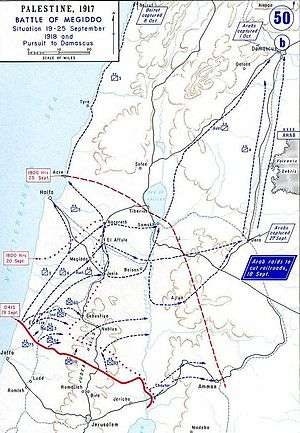 General Allenby's final attacks of the Palestine Campaign gave Britain control of the area.
General Allenby's final attacks of the Palestine Campaign gave Britain control of the area.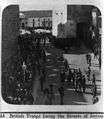 Field Marshal Allenby entering Jerusalem with British troops on 11 December 1917
Field Marshal Allenby entering Jerusalem with British troops on 11 December 1917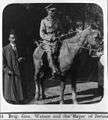 General Watson meeting with the Mayor of Jerusalem in December 1917
General Watson meeting with the Mayor of Jerusalem in December 1917 The surrender of Jerusalem by the Ottomans to the British on 9 December 1917 following the Battle of Jerusalem
The surrender of Jerusalem by the Ottomans to the British on 9 December 1917 following the Battle of Jerusalem Main post office, Jaffa Road, Jerusalem
Main post office, Jaffa Road, Jerusalem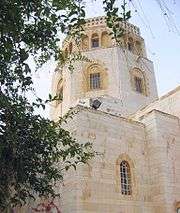 The Rockefeller Museum, built in Jerusalem during the British Mandate
The Rockefeller Museum, built in Jerusalem during the British Mandate- Main post office, Jaffa
 The Anglo-Palestine Bank
The Anglo-Palestine Bank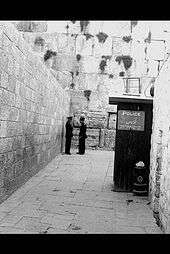 The Western Wall, 1933
The Western Wall, 1933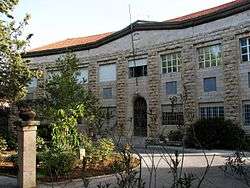 Supreme Military Tribunal of the British Mandate, Kiryat Shmuel, Jerusalem
Supreme Military Tribunal of the British Mandate, Kiryat Shmuel, Jerusalem- YMCA in Jerusalem, built during the British Mandate
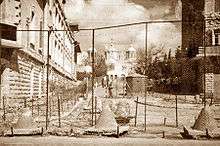 "Bevingrad" in Jerusalem, Russian Compound behind barbed wire
"Bevingrad" in Jerusalem, Russian Compound behind barbed wire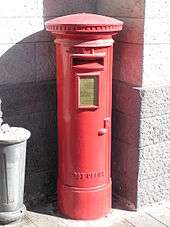 Mandate-era mailbox, Jerusalem
Mandate-era mailbox, Jerusalem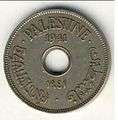 1941 currency coin
1941 currency coin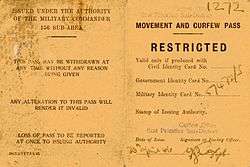 Movement and curfew pass, issued under the authority of the British Military Commander, East Palestine, 1946
Movement and curfew pass, issued under the authority of the British Military Commander, East Palestine, 1946
See also
- Ernest Bevin
- Herbert Dowbiggin (1880–1966) – police expert
- Faisal–Weizmann Agreement (1919)
- Haavara Agreement (1933)
- High Commissioners for Palestine and Transjordan
- Israeli Declaration of Independence
- List of post offices in the British Mandate of Palestine
- Mandatory Palestine passport
- Museum of Underground Prisoners
- Palestinian Citizenship Order, 1925
- Palestine Command
- Palestine pound
- Postage stamps and postal history of Palestine
- Russian Compound
- Charles Tegart (1881–1946) – police expert. The Tegart police forts are named after him.
- Tegart's Wall
- The Sergeants affair
- Liberal Party (Mandatory Palestine)
References
- "League of Nations decision confirming the Principal Allied Powers' agreement on the territory of Palestine". Archived from the original on 2013-11-25.
- Hughes, Matthew, ed. (2004). Allenby in Palestine: The Middle East Correspondence of Field Marshal Viscount Allenby June 1917 – October 1919. Army Records Society. 22. Phoenix Mill, Thrupp, Stroud, Gloucestershire: Sutton Publishing Ltd. ISBN 978-0-7509-3841-9. Allenby to Robertson 25 January 1918 in Hughes 2004, p. 128
- Article 22, The Covenant of the League of Nations and "Mandate for Palestine," Encyclopaedia Judaica, Vol. 11, p. 862, Keter Publishing House, Jerusalem, 1972
- Nur Masalha (2018). Palestine: A Four Thousand Year History. Zed. ISBN 978-1-78699-272-7. Chapter 9: Being Palestine, becoming Palestine, p. 287: "the sense of continuity between the ancient, medieval and modern political geography and naming traditions of Palestine eventually came into play in the designation of the British Mandatory Government of Palestine". The preceding pages, p.259-287, document in detail the usage of the term Palestine by native Palestinians from the moment the printing press was introduced into the area in the late 19th century.
- Khalidi 1997, pp. 151–152.
- Büssow, Johann (2011-08-11). Hamidian Palestine: Politics and Society in the District of Jerusalem 1872-1908. BRILL. p. 5. ISBN 978-90-04-20569-7. Retrieved 2013-05-17.
- |The 1915 Filastin Risalesi ("Palestine Document") is a country survey of the VIII Corps of the Ottoman Army, which identified Palestine as a region including the sanjaqs of Akka (the Galilee), the Sanjaq of Nablus, and the Sanjaq of Jerusalem (Kudus Sherif), see Ottoman Conceptions of Palestine-Part 2: Ethnography and Cartography, Salim Tamari
- Nur Masalha (2018). Palestine A Four Thousand year History. Zed Books. pp. 242–245. ISBN 978-1-78699-274-1.
- League of Nations, Permanent Mandate Commission, Minutes of the Ninth Session Archived 2011-06-28 at the Wayback Machine (Arab Grievances), Held at Geneva from June 8th to 25th, 1926,
- Ira M. Lapidus, A History of Islamic Societies, 2002: "The first were the nationalists, who in 1918 formed the first Muslim-Christian associations to protest against the Jewish national home" p.558
- Tessler, A History of the Israeli-Palestinian Conflict, Second Edition, 2009: "An All-Palestine Congress, known also as the First Congress of the Muslim-Christian Societies, was organised by the MCA and convened in Jerusalem in February 1919." p.220-221
- "First Arab Congress 1919 Paris Resolution (in Arabic)" (PDF). ecf.org.il.
- "Palestine Through History: A Chronology (I)". Archived from the original on June 17, 2011. Retrieved 2016-02-14.CS1 maint: BOT: original-url status unknown (link) The Palestine Chronicle
- Official Records of the Second Session of the General Assembly, Supplement No. 11, United Nations Special Committee on Palestine, Report to the General Assembly, Volume 1. Lake Success, NY, 1947. A/364, 3 September 1947, Chapter II.C.68. Archived 3 June 2014 at the Wayback Machine
- Shamir, Ronen (2013) Current Flow: The Electrification of Palestine Stanford: Stanford University Press
- Caplan, Neil. Palestine Jewry and the Arab Question, 1917 – 1925. London and Totowa, NJ: F. Cass, 1978. ISBN 0-7146-3110-8. pp. 148–161.
- Mattar, Philip (2003). "al-Husayni, Amin". In Mattar, Philip (ed.). Encyclopedia of the Palestinians (Revised ed.). New York: Facts On File. ISBN 978-0-8160-5764-1.
- "It was not scholarly religious credentials that made Hajj Amin an attractive candidate for president of the SMC in the eyes of colonial officials. Rather, it was the combination of his being an effective nationalist activist and a member of one of Jerusalem's most respected notable families that made it advantageous to align his interests with those of the British administration and thereby keep him on a short tether." Weldon C. Matthews, Confronting an Empire, Constructing a Nation: Arab Nationalists and Popular Politics in Mandate Palestine, I.B.Tauris, 2006 pp. 31–32
- For details see Yitzhak Reiter, Islamic Endowments in Jerusalem under British Mandate, Frank Cass, London Portland, Oregon, 1996
- Excluding funds for land purchases. Sahar Huneidi, A Broken Trust: Herbert Samuel, Zionism and the Palestinians 1920–1925, I.B. Tauris, London and New York, 2001 p. 38. The 'Jewish Agency', mentioned in article 4 of the Mandate only became the official term in 1928. At the time the organisation was called the Palestine Zionist Executive.
- 1922 Palestine Order in Council Archived 2014-09-16 at the Wayback Machine
- "Palestine. The Constitution Suspended. Arab Boycott Of Elections. Back To British Rule" The Times, 30 May 1923, p. 14, Issue 43354
- Legislative Council (Palestine) Answers.com
- Las, Nelly. "International Council of Jewish Women". International Council of Jewish Women. Retrieved 20 November 2018.
- League of Nations, Official Journal, October 1923, p. 1217.
- Segev, Tom (1999). One Palestine, Complete. Metropolitan Books. pp. 360–362. ISBN 978-0-8050-4848-3.
- Smith, Charles D. (2007). Palestine and the Arab–Israeli Conflict: A History with Documents (Sixth ed.). pp. 111–225.
- Gilbert 1998, p. 85: The Jewish Settlement Police were created and equipped with trucks and armoured cars by the British working with the Jewish Agency.
- "The Zionism of Orde", Covenant, 3, IDC
- Reuven Firestone (2012). Holy War in Judaism: The Fall and Rise of a Controversial Idea. Oxford University Press. p. 192. ISBN 978-0-19-986030-2.
- "Aljazeera: The history of Palestinian revolts". Archived from the original on December 15, 2005. Retrieved 2005-12-15.
- (Khalidi 1987, p. 845)
- (Khalidi 2001)
- William Roger Louis, Ends of British Imperialism: The Scramble for Empire, Suez, and Decolonization, 2006, p. 391
- Benny Morris, One State, Two States: Resolving the Israel/Palestine Conflict, 2009, p. 66
- Benny Morris, The Birth of the Palestinian Refugee Problem Revisited, p. 48; p. 11 "while the Zionist movement, after much agonising, accepted the principle of partition and the proposals as a basis for negotiation"; p. 49 "In the end, after bitter debate, the Congress equivocally approved—by a vote of 299 to 160—the Peel recommendations as a basis for further negotiation."
- 'Zionists Ready To Negotiate British Plan As Basis', The Times Thursday, 12 August 1937; p. 10; Issue 47761; col B.
- Eran, Oded. "Arab-Israel Peacemaking." The Continuum Political Encyclopedia of the Middle East. Ed. Avraham Sela. New York: Continuum, 2002, p. 122.
- Letter from David Ben-Gurion to his son Amos, written 5 October 1937, Obtained from the Ben-Gurion Archives in Hebrew, and translated into English by the Institute of Palestine Studies, Beirut
- Morris, Benny (2011), Righteous Victims: A History of the Zionist-Arab Conflict, 1881-1998, Knopf Doubleday Publishing Group, p. 138, ISBN 9780307788054 Quote: "No Zionist can forgo the smallest portion of the Land Of Israel. [A] Jewish state in part [of Palestine] is not an end, but a beginning ….. Our possession is important not only for itself … through this we increase our power, and every increase in power facilitates getting hold of the country in its entirety. Establishing a [small] state …. will serve as a very potent lever in our historical effort to redeem the whole country"
- Finkelstein, Norman (2005), Beyond Chutzpah: On the Misuse of Anti-semitism and the Abuse of History, University of California Press, p. 280, ISBN 9780520245983
- Quote from a meeting of the Jewish Agency executive in June 1938: “[I am] satisfied with part of the country, but on the basis of the assumption that after we build up a strong force following the establishment of the state, we will abolish the partition of the country and we will expand to the whole Land of Israel.” in
Masalha, Nur (1992), Expulsion of the Palestinians: The Concept of "Transfer" in Zionist Political Thought, 1882–1948, Inst for Palestine Studies, p. 107, ISBN 9780887282355; and
Segev, Tom (2000), One Palestine, Complete: Jews and Arabs Under the British Mandate, Henry Holt and Company, p. 403, ISBN 9780805048483 - From a letter from Chaim Weizmann to Arthur Grenfell Wauchope, High Commissioner for Palestine, while the Peel Commission was convening in 1937: “We shall spread in the whole country in the course of time ….. this is only an arrangement for the next 25 to 30 years.” Masalha, Nur (1992), Expulsion of the Palestinians: The Concept of "Transfer" in Zionist Political Thought, 1882-1948, Inst for Palestine Studies, p. 62, ISBN 9780887282355
- Why Italian Planes Bombed Tel-Aviv? Archived 2011-09-21 at the Wayback Machine
- How the Palmach was formed (History Central)
- Secret World War II documents released by the UK in July 2001, include documents on Operation ATLAS (See References: KV 2/400–402. A German task force led by Kurt Wieland parachuted into Palestine in September 1944. This was one of the last German efforts in the region to attack the Jewish community in Palestine and undermine British rule by supplying local Arabs with cash, arms and sabotage equipment. The team was captured shortly after landing.
- Moshe Pearlman (1947). Mufti of Jerusalem; the story of Haj Amin el Husseini. V. Gollancz. p. 50.
- Rolf Steininger (17 December 2018). Germany and the Middle East: From Kaiser Wilhelm II to Angela Merkel. Berghahn Books. pp. 55–. ISBN 978-1-78920-039-3.
- Corrigan, Gordon. The Second World War Thomas Dunne Books, 2011 ISBN 9780312577094 p. 523, last paragraph
- Lenk, RS (1994). The Mauritius Affair, The Boat People of 1940–41. London: R Lenk. ISBN 978-0951880524.
- Aroni, Samuel (2002–2007). "Who Perished On The Struma And How Many?". JewishGen.org.
- Подводная лодка "Щ-215". Черноморский Флот информационный ресурс (in Russian). 2000–2013. Retrieved 27 March 2013.
- "מפקורה SS Mefküre Mafkura Mefkura". Haapalah / Aliyah Bet. 27 September 2011. Retrieved 26 March 2013.
- The "Hunting Season" (1945) by Yehuda Lapidot (Jewish Virtual Library)
- UN Doc A/364 Add. 1 of 3 September 1947 Archived 3 June 2014 at the Wayback Machine
- Kenneth Harris, Attlee (1982) pp 388–400.
- Howard Adelman, "UNSCOP and the Partition Recommendation." (Centre for Refugee Studies, York University, 2009) online.
- "A/RES/181(II) of 29 November 1947". United Nations. 1947. Archived from the original on 24 May 2012. Retrieved 11 January 2012.
- Cathy Hartley; Paul Cossali (2004). Survey of Arab-Israeli Relations. pp. 52–53. ISBN 9781135355272.
- Article 11 of the United Nations Charter
- Roosevelt, Kermit (1948). "The Partition of Palestine: A lesson in pressure politics". Middle East Journal. 2 (1): 1–16. JSTOR 4321940.
- Snetsinger, John (1974). Truman, the Jewish vote, and the creation of Israel. Hoover Institution. pp. 66–67.
- Sarsar, Saliba (2004). "The question of Palestine and United States behavior at the United Nations". International Journal of Politics, Culture and Society. 17 (3): 457–470. doi:10.1023/B:IJPS.0000019613.01593.5e.
- Benny Morris (2008). 1948: a history of the first Arab-Israeli war. Yale University Press. Retrieved 24 July 2013.
- "UNITED NATIONS CONCILIATION COMMISSION FOR PALESTINE A/AC.25/W/19 30 July 1949: (Working paper prepared by the Secretariat)". Archived from the original on 2 October 2013. Retrieved 24 August 2013.CS1 maint: BOT: original-url status unknown (link)
- "Palestine". Encyclopædia Britannica Online School Edition, 2006. 15 May 2006.
- Stefan Brooks (2008). "Palestine, British Mandate for". In Spencer C. Tucker (ed.). The Encyclopedia of the Arab-Israeli Conflict. 3. Santa Barbara, California: ABC-CLIO. p. 770. ISBN 978-1-85109-842-2.
- A. J. Sherman (2001). Mandate Days: British Lives in Palestine, 1918–1948. The Johns Hopkins University Press. ISBN 978-0-8018-6620-3.
- Menachem Begin (1977). "The Revolt".
- See Mandates, Dependencies and Trusteeship, by H. Duncan Hall, Carnegie Endowment, 1948, pp. 266–267.
- "The Mandate is Indivisble". Historical Jewish Press, Tel Aviv University, Palestine Post. 9 April 1946. p. 3. Archived from the original on 29 September 2010.
- "The Near East and Africa". Foreign relations of the United States. 1947. p. 1255.
- Snetsinger, John (1974). Truman, the Jewish vote, and the creation of Israel. Hoover Press. pp. 60–61. ISBN 978-0-8179-3391-3.
- "The Near East and Africa, Volume V (1947)". United States Department of State, Foreign relations of the United States. p. 1271.
- The British Empire in the Middle East, 1945–1951, p. 348. William Roger Louis, Clarendon Press, 1984
- "Violence Ebbs; British Police Withdrawn from Tel Aviv and Its Environs - Jewish Telegraphic Agency". www.jta.org.
- Michael J Cohen (24 February 2014). Britain's Moment in Palestine: Retrospect and Perspectives, 1917-1948. Routledge. pp. 481–. ISBN 978-1-317-91364-1.
- "British Forces in Jerusalem Alerter Following Haifa Victory; Fear Haganah Raid on City - Jewish Telegraphic Agency". www.jta.org.
- "PALESTINE BILL (Hansard, 10 March 1948)". hansard.millbanksystems.com.
- Herzog, Chaim and Gazit, Shlomo: The Arab-Israeli Wars: War and Peace in the Middle East from the 1948 War of Independence to the Present, p. 46
- "'U.N. Resolution 181 (II). Future Government of Palestine, Part 1-A, Termination of Mandate, Partition and Independence". Archived from the original on February 7, 2009. Retrieved 2017-05-20.CS1 maint: BOT: original-url status unknown (link)
- U.N. Resolution 181 (II). Future Government of Palestine, Part 1-A, Termination of Mandate, Partition and Independence Archived 2006-10-29 at the Wayback Machine.
- "President Truman's Trusteeship Statement - 1948". www.mideastweb.org.
- Israel Ministry of Foreign Affairs: Declaration of Establishment of State of Israel: 14 May 1948: Retrieved 10 April 2012
- Bier, Aharon, & Slae, Bracha,For the sake of Jerusalem, Mazo Publishers, 2006, p. 49
- Declaration of the Establishment of the State of Israel, 14 May 1948.
- J. Sussmann (1950). "Law and Judicial Practice in Israel". Journal of Comparative Legislation and International Law. 32: 29–31.
- "Copy of telegram from Epstein to Shertok" (PDF). Government of Israel. Archived from the original (PDF) on 13 November 2013. Retrieved 3 May 2013.
- "Our Documents - Press Release Announcing U.S. Recognition of Israel (1948)". www.ourdocuments.gov.
- "Palestine Passports Cease to Give British Protection After May Govt. Announces - Jewish Telegraphic Agency". www.jta.org.
- Masalha, Nur (1992). "Expulsion of the Palestinians." Institute for Palestine Studies, this edition 2001, p. 175.
- Rashid Khalidi (September 1998). Palestinian identity: the construction of modern national consciousness. Columbia University Press. pp. 21–. ISBN 978-0-231-10515-6. Retrieved 22 January 2011. "In 1948 half of Palestine's… Arabs were uprooted from their homes and became refugees"
- Khalidi, Edward Said Professor of Arab Studies Rashid; Khalidi, Rashid. Palestinian Identity: The Construction of Modern National Consciousness. ISBN 9780231527163.
- Appendix IX-B, 'The Arab Expeditionary Forces to Palestine, 15/5/48, Khalidi, 1971, p. 867.
- Bayliss, 1999, p. 84.
- See Papers relating to the foreign relations of the United States "The Paris Peace Conference". 1919. p. 94.
- League of Nations Union. "Summary of the work of the League of Nations, January 1920-March 1922". [London – via Internet Archive.
- "Internet History Sourcebooks". www.fordham.edu.
- See Defending the Rights of Others, by Carol Fink, Cambridge University, 2006, ISBN 0-521-02994-5, p. 28
- See the Statement of the Principal Accredited Representative, Hon. W. Ormsby-Gore, C.330.M.222, Mandate for Palestine – Minutes of the Permanent Mandates Commission/League of Nations 32nd session, 18 August 1937 Archived 3 June 2011 at the Wayback Machine
- See the Judgment in "Legal Consequences of the Construction of a Wall in the Occupied Palestinian Territory" Archived 2011-01-12 at the Wayback Machine (PDF)
- See paragraphs 49, 70, and 129 of the International Court of Justice Advisory Opinion, Legal Consequences of the Construction of a Wall in the Occupied Palestinian Territory PDF Archived 2010-07-06 at the Wayback Machine and PAUL J. I. M. DE WAART (2005). "International Court of Justice Firmly Walled in the Law of Power in the Israeli–Palestinian Peace Process." Leiden Journal of International Law, 18, pp. 467–487, doi:10.1017/S0922156505002839
- (Khalidi 2006, pp. 32–33)
- (Khalidi 2006, pp. 33–34)
- "Palestine. The Constitution Suspended., Arab Boycott Of Elections., Back To British Rule" The Times, 30 May 1923, p. 14, Issue 43354
- (Khalidi 2006, pp. 32, 36)
- See Foreign relations of the United States, 1947. The Near East and Africa Volume V, p. 1033
- "Anatomy of the 1936–39 Revolt: Images of the Body in Political Cartoons of Mandatory Palestine". 1 January 2008. Retrieved 14 January 2008.
- "Filastin". National Library of Israel. Retrieved 4 March 2019.
- In June 1947, the British Mandate Government of Palestine had published the following statistics: "It is estimated that over a quarter of the Jewish population in Palestine are Sephardic Jews of whom some 60,000 were born of families resident in Palestine for centuries. The bulk of the Sephardic community, however, consists of oriental Jews emanating from Syria, Egypt, Persia, Iraq, Georgia, Bokhara and other Eastern countries. They are confined mainly to the larger towns ..." (From: Supplement to Survey of Palestine - Notes compiled for the information of the United Nations Special Committee on Palestine - June 1947, Gov. Printer Jerusalem, pp. 150–151)
- "Jewish Agency History". Archived from the original on February 15, 2006. Retrieved 2012-01-29.CS1 maint: BOT: original-url status unknown (link)
- Palestine Jewry and the Arab Question, 1917–1925, by Caplan, Neil. London and Totowa, NJ: F. Cass, 1978. ISBN 0-7146-3110-8. pp. 161–165.
- A Survey of Palestine: Prepared in December 1945 and January 1946 for the Information of the Anglo-American Committee of Inquiry. 1. Palestine: Govt. printer. 1946. p. 185.
- A Survey of Palestine: Prepared in December 1945 and January 1946 for the Information of the Anglo-American Committee of Inquiry. 1. Palestine: Govt. printer. 1946. p. 210: "Arab illegal immigration is mainly ... casual, temporary and seasonal". pp. 212: "The conclusion is that Arab illegal immigration for the purpose of permanent settlement is insignificant".
- J. McCarthy (1995). The population of Palestine: population history and statistics of the late Ottoman period and the Mandate. Princeton, N.J.: Darwin Press.
- Supplement to Survey of Palestine - Notes compiled for the information of the United Nations Special Committee on Palestine - June 1947, Gov. Printer Jerusalem, p. 18
- John B. Quigley (2010). The Statehood of Palestine: International Law in the Middle East Conflict. Cambridge University Press. p. 54. ISBN 978-0-521-15165-8.
- See History of Zionism (1600–1918), Volume I, Nahum Sokolow, 1919 Longmans, Green, and Company, London, pp. xxiv–xxv
- "The Avalon Project : The Palestine Mandate". avalon.law.yale.edu.
- See the report of the United Nations Special Committee on Palestine, UN Document A/364, 3 September 1947
- Memorandum By The Secretary of State for the Colonies, "PALESTINE: HIGH COMMISSIONERS VIEWS ON POLICY", March 1930, UK National Archives Cabinet Paper CAB/24/211, formerly C.P. 108 (30)
- "PERMANENT MANDATES COMMISSION MINUTES OF THE TWENTY-SECOND SESSION". LEAGUE OF NATIONS. Archived from the original on 10 August 2011. Retrieved 8 June 2010.
- See Partner to Partition: The Jewish Agency's Partition Plan in the Mandate Era, by Yossi Katz, Routledge, 1998, ISBN 0-7146-4846-9
- "FRUS: Foreign relations of the United States diplomatic papers, 1937. The British Commonwealth, Europe, Near East and Africa: Palestine". digicoll.library.wisc.edu.
- See Letters to Paula and the Children, David Ben Gurion, translated by Aubry Hodes, University of Pittsburgh Press, 1971 pp. 153–157
- See Righteous Victims: A History of the Zionist–Arab Conflict, 1881–1999, by Benny Morris, Knopf, 1999, ISBN 0-679-42120-3, p. 138
- See Scars of war, Wounds of Peace: The Israeli–Arab Tragedy, by Shlomo Ben-Ami, Oxford University Press, USA, 2006, ISBN 0-19-518158-1, p. 17
- "Avalon Project - Anglo-American Committee of Inquiry - Chapter V". avalon.law.yale.edu.
- See Foreign relations of the United States, 1946, The Near East and Africa Volume VII, pp. 692–693
- Stein 1984, p. 4
- "Land Ownership in Palestine," CZA, KKL5/1878. The statistics were prepared by the Palestine Lands Department for the Anglo-American Committee of Inquiry, 1945, ISA, Box 3874/file 1. See (Khalaf 1991, p. 27)
- Stein 1984, p. 226
- Avneri 1984, p. 224
- Stein 1984, pp. 3–4, 247
- Michael R. Fischbach (13 August 2013). Jewish Property Claims Against Arab Countries. Columbia University Press. p. 24. ISBN 978-0-231-51781-2.
By 1948, after several decades of Jewish immigration, the Jewish population of Palestine had risen to about one third of the total, and Jews and Jewish companies owned 20 percent of all cultivable land in the country
- Lorenzo Kamel (2014), "Whose Land? Land Tenure in Late Nineteenth- and Early Twentieth-Century Palestine", British Journal of Middle Eastern Studies, pp. 230–242. http://www.tandfonline.com/doi/pdf/10.1080/13530194.2013.878518
- Land Ownership of Palestine Archived 2008-10-29 at the Wayback Machine – Map prepared by the Government of Palestine on the instructions of the UN Ad Hoc Committee on the Palestine Question.
- Table 2 showing Holdings of Large Jewish Lands Owners as of December 31st, 1945, British Mandate: A Survey of Palestine: Volume I – Page 245. Chapter VIII: Land: Section 3., prepared by the British Mandate for the United Nations Survey of Palestine Retrieved 4 July 2015
- Anglo-American Committee of Inquiry on Jewish Problems in Palestine and Europe, J. V. W. Shaw, General Assembly, Special Committee on Palestine, United Nations (1991). A Survey of Palestine: Prepared in December, 1945 and January, 1946 for the Information of the Anglo-American Committee of Inquiry. 1. Institute for Palestine Studies. ISBN 978-0-88728-211-9.CS1 maint: multiple names: authors list (link)
- Ownership of land in Palestine, Share of Palestinan (sic) Arabs and Jews as of 1 April 1943, prepared by the British Mandate for the United Nations Survey of Palestine Retrieved 25 August 2014
- ibid, Supplement p30.
- A Survey of Palestine (Prepared in December 1945 and January 1946 for the information of the Anglo-American Committee of Inquiry), vol. 1, chapter VIII, section 7, Government Printer of Jerusalem, pp. 260–262
- ""Hope Simpson report, Chapter III". Zionism-israel.com. October 1930.
- Mills, E. Census of Palestine, 1931 (UK government, 1932), Vol I, pp. 61–65.
- The Political History of Palestine under British Administration, Memorandum to the United Nations Special Committee
- prepared in December 1945 and January 1946 for the information of the Anglo-American Committee of Inquiry. (1991). A Survey of Palestine: Prepared in December, 1945 and January, 1946 for the Information of the Anglo-American Committee of Inquiry. 1. Institute for Palestine Studies. pp. 12–13. ISBN 978-0-88728-211-9.
- The Palestine Order in Council, 10 August 1922, article 11 Archived 16 September 2014 at the Wayback Machine: "The High Commissioner may, with the approval of a Secretary of State, by Proclamation divide Palestine into administrative divisions or districts in such manner and with such subdivisions as may be convenient for purposes of administration describing the boundaries thereof and assigning names thereto."
- Likhovski, Assaf. Law and Identity in Mandate Palestine. p. 64.
- "H.h. Trusted Named Chief Justice of Palestine". Jewish Telegraphic Agency. Retrieved 18 November 2015.
- LikHovski, Assaf. Law and Identity in Mandate Palestine. p. 74.
- LikHovski, Assaf. Law and Identity in Mandate Palestine. p. 75.
- (Khalidi 2006, pp. 13–14)
- (Khalidi 2006, p. 27)
- Shamir, Ronen (2013). Current Flow: The Electrification of Palestine. Stanford: Stanford University Press.
- Noam Dvir (5 April 2012). "Haifa's glass house transparent, but still an Israeli mystery". Haaretz.
- (Khalidi 2006, p. 16)
- (Khalidi 2006, p. 17)
- (Khalidi 2006, pp. 29–30)
- "The Jewish Community Under the Palestine Mandate". www.jewishvirtuallibrary.org.
- (Khalidi 2006, pp. 14, 24)
Notes
- During its existence the territory was known simply as Palestine, but, in later years, a variety of other names and descriptors have been used, including Mandatory or Mandate Palestine, the British Mandate of Palestine and British Palestine.
- Historian Nur Masalha describes the "British preoccupation with Palestine" and the large increase in European books, articles, travelogues and geographical publications during the 18th and 19th centuries.[8]
- From Himmler:
The National Socialist movement of Greater Germany has, since its inception, inscribed upon its flag the fight against the world Jewry. It has therefore followed with particular sympathy the struggle of freedom-loving Arabs, especially in Palestine, against Jewish interlopers. In the recognition of this enemy and of the common struggle against it lies the firm foundation of the natural alliance that exists between the National Socialist Greater Germany and the freedom-loving Muslims of the whole world. In this spirit I am sending you on the anniversary of the infamous Balfour declaration my hearty greetings and wishes for the successful pursuit of your struggle until the final victory.
From Ribbentrop:I am sending my greetings to your eminence and to the participants of the meeting held today in the Reich capital under your chairmanship. Germany is linked to the Arab nation by old ties of friendship, and today we are united more than ever before. The elimination of the socalled Jewish national home and the liberation of all Arab countries from the oppression and exploitation of the Western powers is an unchangeable part of the Great German Reich policy. Let the hour not be far off when the Arab nation will be able to build its future and find unity in full independence.
- p. 50, at 1947 "Haj Amin al-Husseini went one better: he denounced also the minority report, which, in his view, legitimised the Jewish foothold in Palestine, a "partition in disguise," as he put it."; p. 66, at 1946 "The League demanded independence for Palestine as a "unitary" state, with an Arab majority and minority rights for the Jews. The AHC went one better and insisted that the proportion of Jews to Arabs in the unitary state should stand at one to six, meaning that only Jews who lived in Palestine before the British Mandate be eligible for citizenship"; p. 67, at 1947 "The League’s Political Committee met in Sofar, Lebanon, on 16–19 September, and urged the Palestine Arabs to fight partition, which it called "aggression," "without mercy." The League promised them, in line with Bludan, assistance "in manpower, money and equipment" should the United Nations endorse partition."; p. 72, at Dec 1947 "The League vowed, in very general language, "to try to stymie the partition plan and prevent the establishment of a Jewish state in Palestine,"[64]
- "The Arabs rejected the United Nations Partition Plan so that any comment of theirs did not specifically concern the status of the Arab section of Palestine under partition but rather rejected the scheme in its entirety."[65]
Bibliography
- Pappé, Ilan (15 August 1994). "Introduction". The Making of the Arab–Israeli Conflict, 1947–1951. I.B.Tauris. ISBN 978-1-85043-819-9. Retrieved 2 May 2009.
- Khalidi, Rashid (2006). The Iron Cage: The Story of the Palestinian Struggle for Statehood. Beacon Press. ISBN 978-0-8070-0308-4. Retrieved 2 May 2009.
- Khalidi, Rashid (2007) [1st ed. 2001]. "The Palestinians and 1948: the underlying causes of failure". In Eugene L. Rogan & Avi Shlaim (ed.). The War for Palestine: Rewriting the History of 1948 (2nd ed.). Cambridge University Press. ISBN 978-0-521-69934-1. Retrieved 2 May 2009.
- Khalidi, Walid (1987) [Original in 1971]. From Haven to Conquest: Readings in Zionism and the Palestine Problem Until 1948. Institute for Palestine Studies. ISBN 978-0-88728-155-6. Retrieved 2 May 2009.
- Khalidi, Rashid (1997), Palestinian Identity: The Construction of Modern National Consciousness, Columbia University Press, ISBN 9780231521741
- Morris, Benny (2001) [1999]. Righteous Victims: A History of the Zionist–Arab Conflict, 1881–1999. New York: Alfred A. Knopf. ISBN 978-0-679-74475-7. Retrieved 2 May 2009.
- Aruri, Naseer Hasan (1972). Jordan: A Study in Political Development 1923–1965. The Hague: Martinus Nijhoff Publishers. ISBN 978-90-247-1217-5. Retrieved 2 May 2009.
- Biger, Gideon (2004). The Boundaries of Modern Palestine, 1840–1947. London: Routledge. ISBN 978-0-7146-5654-0. Retrieved 2 May 2009.
- Louis, Wm. Roger (1969). "The United Kingdom and the Beginning of the Mandates System, 1919–1922". International Organization. 23 (1): 73–96. doi:10.1017/s0020818300025534.
- Segev, Tom (2001) [Original in 2000]. "Nebi Musa, 1920". One Palestine, Complete: Jews and Arabs Under the British Mandate. Trans. Haim Watzman. London: Henry Holt and Company. ISBN 978-0-8050-6587-9. Retrieved 2 May 2009.
- Stein, Kenneth W. (1987) [Original in 1984]. The Land Question in Palestine, 1917–1939. University of North Carolina Press. ISBN 978-0-8078-4178-5. Retrieved 2 May 2009.
- Gilbert, Martin (1998). Israel: a history. Doubleday. ISBN 978-0-385-40401-3. Retrieved 2 May 2009.
- Shapira, Anita (1992). Land and Power: The Zionist Resort to Force, 1881–1948. trans. William Templer. Oxford University Press. ISBN 978-0-19-506104-8. Retrieved 2 May 2009.
- Black, Ian (1991). Israel's Secret Wars: A History of Israel's Intelligence Services. Morris, Benny. Grove Press. ISBN 978-0-8021-1159-3.
- Avneri, Aryeh L. (1984). The Claim of Dispossession: Jewish Land-Settlement and the Arabs, 1878–1948. Transaction Publishers. ISBN 978-0-87855-964-0. Retrieved 2 May 2009.
- Khalaf, Issa (1991). Politics in Palestine: Arab Factionalism and Social Disintegration, 1939–1948. State University of New York Press. ISBN 978-0-7914-0708-0. Retrieved 6 May 2009.
- Bayliss, Thomas (1999). How Israel Was Won: A Concise History of the Arab–Israeli Conflict. Lexington Books. ISBN 978-0-7391-0064-6
- Bethell, Nicholas The Palestine Triangle: the Struggle Between the British, the Jews and the Arabs, 1935–48, London: Deutsch, 1979 ISBN 0-233-97069-X.
- El-Eini, Roza I.M. (2006). Mandated Landscape: British Imperial Rule in Palestine, 1929–1948. London: Routledge. ISBN 978-0-7146-5426-3. Retrieved 5 May 2009.
- Hughes, Matthew, ed. (2004). Allenby in Palestine: The Middle East Correspondence of Field Marshal Viscount Allenby June 1917 – October 1919. Army Records Society. 22. Phoenix Mill, Thrupp, Stroud, Gloucestershire: Sutton Publishing Ltd. ISBN 978-0-7509-3841-9.
- Katz, Shmuel (1973). Battleground: Fact and Fantasy in Palestine. Bantam Books. ISBN 978-0-929093-13-0. Retrieved 2 May 2009.
- Paris, Timothy J. (2003). Britain, the Hashemites and Arab Rule, 1920–1925: The Sherifian Solution. London: Routledge. ISBN 0-7146-5451-5
- Sherman, A J (1998).Mandate Days: British Lives in Palestine, 1918–1948, Thames & Hudson. ISBN 0-8018-6620-0
- Vareilles, Guillaume (2010). Les frontières de la Palestine, 1914–1947, Paris, L'Harmattan. ISBN 978-2-296-13621-2
Further reading
- Bar-Yosef, Eitan. "Bonding with the British: Colonial Nostalgia and the Idealization of Mandatory Palestine in Israeli Literature and Culture after 1967." Jewish Social Studies 22.3 (2017): 1-37. online
- Cohen, Michael J. Britain's Moment in Palestine: Retrospect and Perspectives, 1917-1948 (2014)
- El-Eini, Roza. Mandated landscape: British imperial rule in Palestine 1929-1948 (Routledge, 2004).
- Galnoor, Itzhak. Partition of Palestine, The: Decision Crossroads in the Zionist Movement (SUNY Press, 2012).
- Hanna, Paul Lamont, "British Policy in Palestine", Washington, D.C., American Council on Public Affairs, (1942)
- Harris, Kenneth. Attlee (1982) pp 388–400.
- Kamel, Lorenzo. "Whose Land? Land Tenure in Late Nineteenth- and Early Twentieth-Century Palestine", "British Journal of Middle Eastern studies" (April 2014), 41, 2, pp. 230–242.
- Miller, Rory, ed. Britain, Palestine and Empire: The Mandate Years (2010)
- Morgan, Kenneth O.The People's Peace: British history 1945 – 1990 (1992) 49-52.
- Ravndal, Ellen Jenny. "Exit Britain: British Withdrawal From the Palestine Mandate in the Early Cold War, 1947–1948," Diplomacy and Statecraft, (Sept 2010) 21#3 pp. 416–433.
- Roberts, Nicholas E. "Re‐Remembering the Mandate: Historiographical Debates and Revisionist History in the Study of British Palestine." History Compass 9.3 (2011): 215-230. online.
- Sargent, Andrew. " The British Labour Party and Palestine 1917-1949" (PhD thesis, University of Nottingham, 1980) online
- Shelef, Nadav G. "From 'Both Banks of the Jordan' to the 'Whole Land of Israel:' Ideological Change in Revisionist Zionism." Israel Studies 9.1 (2004): 125-148. Online
- Sinanoglou, Penny. "British Plans for the Partition of Palestine, 1929–1938." Historical Journal 52.1 (2009): 131-152. online
- Wright, Quincy, The Palestine Problem, Political Science Quarterly, 41#3 (1926), pp. 384–412, online.


